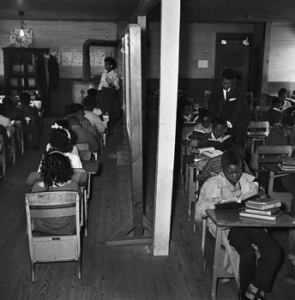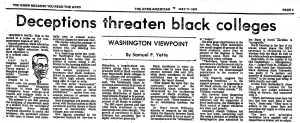Brown V. Board of Education(1954)

This is a photo of Linda brown. In 1951 she was 8 year old in third grade, when her father started pursuing a case commonly known as Brown V. Board of Education of Topeka (1954). In this case the court decided that legally mandated racial segregation in the public schools was unconstitutional, because it violated the “equal protection of laws” of the Fourteenth Amendment to the Constitution. By directly asking the courts to challenge the Fourteenth amendment, it was also asking them to describe the meaning of it, which therefore caused them to analyze this case in terms of it. The nation was held at surprise with the courts decision and received many pushbacks. Therefore this case did not lead to an immediate end to segregation, because this case was in its form a social revolution that asked people to change their lives and mindsets in ways never asked before. Therefore the court was forced to argue a second case Brown II (1955), in which the court ordered that integration needed to be supervised by district courts in all the states that were receiving major pushback by the people [1]. This case is an example of the people not being ready for change regarding education, the traces of segregation by race are still seen today mainly in diverse cities where private schools are mostly White students and public schools are mostly Black and minority students.
After the court ruling of Brown Vs. Board (1954), the nation specially southern states emitted large pushback to the oder of integration. Policies of large resistance took the nation that lead to the creation of the “Southern Manifesto” (1956), which was issues by nineteen senators and eighty-one congressman who supported the massive resistance throughout the nation [2]. White supremacy groups also played a role in the integrating schools court decision, this groups intimidated black parents who were tying to register their children to integrated schools. In addition some governors even stood in schools doors to block the black students from going in [2]. Violence was a large part of the resistance, schools that implemented integration were burned, home of black lawyers were destroyed, and black churches were bombed. President Dwight D. Eisenhower finally decided to send troops to Arkansas in 1957 in order to help stop the violence in Central High School in Little Rock. The violence in Little Rock erupted when 9 black intelligent students were admitted to the school. These nine students were protected while entering the school and guarded while walking campus. These 9 students were known as the Little Rock Nine. Little Rock Nine were a sign of progress in education and a sign that the government was making an attempt at fostering this progress.
Schools In Poor Condition (1961)

This photo demonstrates the bad conditions in which black schools were. In the image there is a single lightbulb and one coal-burning stove which show the inequitable conditions that black students had no choice but to learn in. How would the nation at this time complain of black students not being at the level of whites in knowledge when the conditions in which they were learning was not even comparable? From this image the concept of institutional racism in education is clearly demonstrated. In the early to mid 20th century educational facilities for black students were inadequate, the teachers in this schools were not well trained or well paid, and too often there was not enough time to teach the students, because the school year was shortened to accommodate the demands of the agricultural economy in southern states [2]. Given that many if not all blacks at that time worked in the agricultural industry in the south. The condition of these facilities relates to today of public schools in underrepresented areas specially in cities are in lesser conditions of private schools, and have less resources to offer to students.
Text of Kennedy Address(1962)

This news article was posted New York, NY. The newspaper displays to congress and people the details of Kennedy’s viewpoints on education. This newspaper explains why the education problem of the United States during the early 1960s was of big concern and should be made priority. It discusses reasons, one of them being a political reason which is that education is the foundation and unifying force of the democratic way of life. Kennedy also addressed the issue of educational inequality in the country. Kennedy backs up the importance of this issue by mentioning that the less people are educated the less they will be a part of the economy, therefore increasing unemployment in the country. There’s also an inequality in the quality of education received by different districts. This source is important because it shows how an inadequate educational system during the early 60s will result in a more inadequate in the future, which is today. Education moves along with history and therefore worsens when its not taken care of.
Courts Threaten Black Colleges(1972)

Published in Philadelphia, Pa in December 19, 1972 this newspaper presents the advances and setbacks of the black colleges standing in the united states during the 1970s. The court’s activity in regard to civil rights act and its potential impact on black colleges is shown. This source speaks on the potential failure of the court to enforce Title VI of the Civil Rights Act of 1964 and its potential destruction of predominately-black public colleges in southern states. Different judges and attorneys’ claim their opinions on the idea of predominantly black colleges violating the desegregation laws after it was clearly demanded to integrate with the court. Some during this time create the excuse to not integrate by saying that it’ll hurt black students to integrate schools that are predominantly one race. Lawyers who agreed with integration accused HEW of not making an effort to make schools districts comply with U.S supreme court desegregation standards. This newspaper brings the ideals of backlash to black education after the court decision of Brown Vs. Board showing a continuation of resistance to integrated education throughout the years following the case.
Deceptions threaten black colleges (1978)

This newspaper from the Washington Viewpoint speaks on the “Career Education” law signed by president Carter. The newspaper believes that this law is a deception because it allows education planners to weed out black young students from college level courses and then transfer them to doing “hands on” experiences. During this time anti-supporters of black students attending white colleges claimed that it was more beneficial for black students to attend all black colleges because it would promote the survival of historically black colleges, this survival is claimed to be threatened by black students attending predominantly white colleges. Though, this newspaper provides statistical evidence refuting this point and showing that percentage increase in attendance of black students was increasing for both White and Black colleges. Still today there are many people that disapprove of black and minority students attending all white college because they believe that it’ll drop the difficulty level to being accepted into a school, by simple stereotype that minorities do not work as hard as others.
Notes
- Finkelman, Paul. “Brown v. Board of Education.” Encyclopedia of African American History, 1896 to the Present: From the Age of Segregation to the Twenty-first Century, edited by Ed. Paul Finkelman. Oxford African American Studies Center,
- Palmer, Annette. “Education.” Encyclopedia of African American History, 1896 to the Present: From the Age of Segregation to the Twenty-first Century, edited by Ed. Paul Finkelman. Oxford African American Studies Center,
